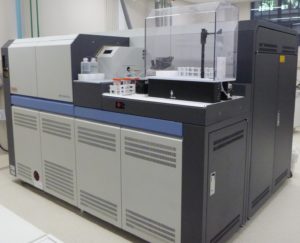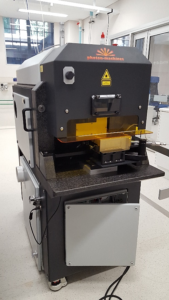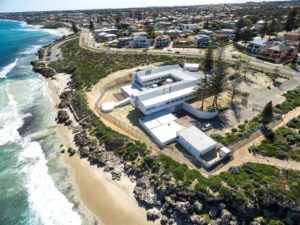
Not Used
UWA’s state-of-the-art, geochemical analytical facility was established by Professor McCulloch in 2010, as part of his UWA Premier’s Fellowship. Since then it has been expanded to meet both solid Earth (Professor Kemp) as well as more general areas of isotope geochemical research. It is now managed by Dr Aleksey Sadekov as part of UWA’s centrally funded CMCA. The facility comprises purpose-built laboratories, a mass spectrometry suite , an Ultra-Clean Laboratory and adjacent sample preparation laboratories. This mass spectrometry suite houses high-end multi-collector mass spectrometers (Neptune -plus) and NU-II), a highly sensitive Element and most recently a triple quad ICPMS and several laser systems. This provides UWA with high-precision, ultra-sensitive isotopic and elemental capabilities applicable to earth and environmental sciences and related disciplines.

All wet chemistry preparation is undertaken in the Clean Laboratory facility. This includes clean acid preparation for instrument calibrations and standard analyses, as well as sample processing such as ion exchange chromatography for solution-based mass spectrometry.
The purpose-built Clean Laboratory provides an ultra-clean HEPA filtered metal-free working environment, catering for all levels of classical and non-standard wet chemistry sample dissolution and chemical extraction procedures. The facility is positively pressured and features air-lock entry, five ULPA filtered ducted laminar flow work hoods, one ULPA laminar flow hood, one fume hood, a Milli-Q ultrapure water supply, PTFE sub-boiling acid stills, and an enclosed weighing room equipped with high precision balances.
The prepFAST automated sample purification system is setup in the Clean Room Facility to maintain a clean working environment during sample processing. This fully automated, syringe-driven low-pressure chromatography system, isolates and elutes the target elements from the dissolved samples for precise isotopic analysis.
The mass spectrometry facility has four inductively coupled plasma mass spectrometers: two double focusing multi-collector inductively coupled plasma mass spectrometers, a Thermo Finnigan NEPTUNE Plus, and an NU Instruments Plasma II, as well as a Thermo ELEMENT XR high resolution ICPMS, and a Thermo triple quad ICPMS.
The MC-ICPMS systems combine the advantage of inductively coupled plasma for superior ionization with the high precision obtained from simultaneous multi-collector data acquisition possible with a high dispersion magnetic sector mass spectrometer. This enables the ionization and hence analysis of most elements, and the measurement of their isotopes ratios and relative mass-fractionations at high precision. The ICP source also provides greater flexibility of how samples are introduced into the mass spectrometer, allowing the analysis of either aspirated solutions or as aerosols produced by direct laser ablation (LA-MC-ICP-MS) of solid materials. Two laser systems are also available which can be coupled to any of the ICPMS systems for high spatial resolution in-situ analysis of solid samples.
The ability to obtain high precision isotopic analyses of a large range of elements made possible by MC-ICPMS in particular enables applications across all fields of science. They are commonly used in geochemistry, geochronology, and the environmental sciences. Our research has a strong focus on environmental geochemistry using biogenic skeletons as archives of seawater chemistry and environmental change, on modern and geological timescales.

The Thermo Scientific NEPTUNE Plus is equipped with eight adjustable Faraday ion collectors, one fixed central collector, and two ion counters, a 1012 Ohm DC-amplifier with reduced noise level, and a larger interface pump for enhanced sensitivity. A high resolution filter (RPQ) is present in the central channel. The multi-ion counting package consists of two CDDs with positions to accommodate precise U-Th and B isotope determinations of very small sample volumes. Solution samples can be introduced via conventional spray chamber using an autosampler and desolvation system, or high spatial resolution analysis of solids can be undertaken using in-situ laser micro-sampling.

The Nu Instruments Plasma II features sixteen fixed Faraday ion collectors to maximize the number and range of isotope analysis. Three full-size discrete dynode multipliers enable isotope ratio measurements of very low abundance isotopes. Enhanced zoom optics focus the ion beams into the fixed collectors and allows instantaneous switching between collector configurations for a range of elements. The Nu Plasma II plasma source operates at high voltage with the analyser being at ground potential operation. Solution samples can be introduced via conventional spray chamber using an autosampler and desolvation system, or high spatial resolution analysis of solids can be undertaken using in-situ laser micro-sampling.
 Thermo ELEMENT XR HR-ICPMS
Thermo ELEMENT XR HR-ICPMSThe ELEMENT XR combines a dual mode SEM with a Faraday detector, enhancing the linear dynamic range by 3-orders of magnitude relative to the ELEMENT 2. This high resolution ICPMS, has excellent sensitivity and signal-to-noise ratio, enabling accurate and reliable quantitative multi-element analyses at trace levels with minimal sample preparation. Solution samples can be introduced via conventional spray chamber using an autosampler, or high spatial resolution analysis of solids can be undertaken using in-situ laser micro-sampling.
The Thermo Triple Quadrupole Inductively Coupled Plasma Mass Spectrometer (Q-ICPMS) enables simultaneous measurements of elemental concentrations from most of the periodic table. It has an ESI SC-FAST auto-sampling system which enables high volume throughput of solution samples. Solution samples can be introduced via conventional spray chamber using an autosampler, or high spatial resolution analysis of solids can be undertaken using in-situ laser micro-sampling.
 Teledyne Photon ANALYTE G2 UV Excimer Laser Ablation System
Teledyne Photon ANALYTE G2 UV Excimer Laser Ablation SystemHigh spatial resolution in-situ microanalytical geochemical analyses can be undertaken on a wide variety of geological and biological solid samples using laser ablation ICPMS (Teledyne Photon ANALYTE G2 & Coherent COMPexPro 110 UV 193 nm Excimer laser systems). High precision isotopic ratios can be measured when coupled to either the NEPTUNE Plus or NU Plasma II MC-ICPMS, or elemental ratios using the ELEMENT XR HR-ICPMS or X-Series 2 Q-ICPMS. The large format, 2-volume sample cell configuration and rotating apertures enables a wide range of spot sizes for either down-hole profiling or continuous scan rasters to track compositions of growth features in different dimensions.
 Saturation State is a 6.7m Stabicraft. Its stability, large fuel tank, work deck, and enclosed cockpit provide an effective workboat used for coral coring, sampling, and SCUBA diving in coastal waters.
Saturation State is a 6.7m Stabicraft. Its stability, large fuel tank, work deck, and enclosed cockpit provide an effective workboat used for coral coring, sampling, and SCUBA diving in coastal waters.

Z-Spar is a 4.2m collapsible zodiac that enables access to very shallow water reefs and beaches for conducting calcification and coastal processes research.
The group has a wide range of field equipment including two trail-able vessels as well as a wide range of seawater monitoring equipment with a focus on the measurement and monitoring of the carbonate chemistry of seawater. Equipment include Pro-Oceanus pCO2 sensors, pH probes, pO2 sensors, temperature loggers, tidal gauges, and salinity sensors. Alkalinity measurements and the calibration of pH probes are undertaken in our laboratory facilities.
 A large part of our wet laboratory experiments are conducted at IOMRC Watermans Bay.
A large part of our wet laboratory experiments are conducted at IOMRC Watermans Bay.
 Recent experiments have focused on understanding the likely impacts of ocean warming and acidification on coral and coralline algae in particular. A one year duration experiment has been examining how variability in temperature can influence the susceptibility of naturally heat-tolerant Kimberley corals to bleaching, and their subsequent recovery. Other work has aimed at understanding how variability in temperature, pH, light and water flow can interact with the impacts of ocean warming and acidification. This will provide some of the first insights into how pH at three various scales potentially alters the response of corals to climate change: 1) in bulk seawater, 2) at the surface of the organism, and 3) internally at the organism site of calcification. A 9-month experiment has been examining the capacity for multiple generations of coralline algae to increase or decrease their tolerance to ocean acidification. These experiments will provide us with a clearer understanding of the key processes underlying the resilience of these organisms to the combined effects of ocean acidification and especially the abrupt increases in ocean temperatures, which cause large-scale bleaching and coral mortality.
Recent experiments have focused on understanding the likely impacts of ocean warming and acidification on coral and coralline algae in particular. A one year duration experiment has been examining how variability in temperature can influence the susceptibility of naturally heat-tolerant Kimberley corals to bleaching, and their subsequent recovery. Other work has aimed at understanding how variability in temperature, pH, light and water flow can interact with the impacts of ocean warming and acidification. This will provide some of the first insights into how pH at three various scales potentially alters the response of corals to climate change: 1) in bulk seawater, 2) at the surface of the organism, and 3) internally at the organism site of calcification. A 9-month experiment has been examining the capacity for multiple generations of coralline algae to increase or decrease their tolerance to ocean acidification. These experiments will provide us with a clearer understanding of the key processes underlying the resilience of these organisms to the combined effects of ocean acidification and especially the abrupt increases in ocean temperatures, which cause large-scale bleaching and coral mortality.